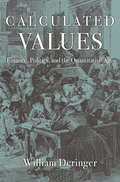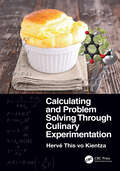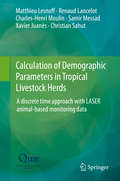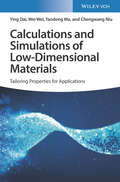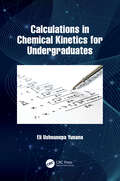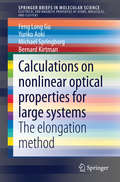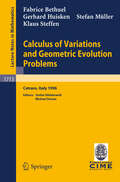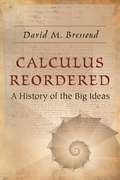- Table View
- List View
Calculated Values: Finance, Politics, and the Quantitative Age
by William DeringerModern political culture features a deep-seated faith in the power of numbers to find answers, settle disputes, and explain how the world works. Whether evaluating economic trends, measuring the success of institutions, or divining public opinion, we are told that numbers don’t lie. But numbers have not always been so revered. Calculated Values traces how numbers first gained widespread public authority in one nation, Great Britain. Into the seventeenth century, numerical reasoning bore no special weight in political life. Complex calculations were often regarded with suspicion, seen as the narrow province of navigators, bookkeepers, and astrologers, not gentlemen. This changed in the decades following the Glorious Revolution of 1688. Though Britons’ new quantitative enthusiasm coincided with major advances in natural science, financial capitalism, and the power of the British state, it was no automatic consequence of those developments, William Deringer argues. Rather, it was a product of politics—ugly, antagonistic, partisan politics. From Parliamentary debates to cheap pamphlets, disputes over taxes, trade, and national debt were increasingly conducted through calculations. Some of the era’s most pivotal political moments, like the 1707 Union of England and Scotland and the 1720 South Sea Bubble, turned upon calculative conflicts. As Britons learned to fight by the numbers, they came to believe, as one calculator wrote in 1727, that “facts and figures are the most stubborn evidences.” Yet the authority of numbers arose not from efforts to find objective truths that transcended politics, but from the turmoil of politics itself.
Calculating and Problem Solving Through Culinary Experimentation
by Hervé This vo KientzaWhile many books proliferate elucidating the science behind the transformations during cooking, none teach the concepts of physics chemistry through problem solving based on culinary experiments as this one by renowned chemist and one of the founders of molecular gastronomy. Calculating and Problem Solving Through Culinary Experimentation offers an appealing approach to teaching experimental design and scientific calculations. Given the fact that culinary phenomena need physics and chemistry to be interpreted, there are strong and legitimate reasons for introducing molecular gastronomy in scientific curriculum. As any scientific discipline, molecular gastronomy is based on experiments (to observe the phenomena to be studied) and calculation (to fit the many data obtained by quantitative characterization of the studied phenomena), but also for making the theoretical work without which no real science is done, including refuting consequences of the introduced theories. Often, no difficult calculations are needed, and many physicists, in particular, make their first steps in understanding phenomena with very crude calculations. Indeed, they simply apply what they learned, before moving to more difficult math. In this book, the students are invited first to make simple experiments in order to get a clear idea of the (culinary) phenomena that they will be invited to investigate, and then are asked simple questions about the phenomena, for which they have to transform their knowledge into skills, using a clear strategy that is explained throughout. Indeed, the is "problem solving based on experiments", and all this about food and cooking. Key Features: • Introduces readers to tips for experimental work • Shows how simple scientific knowledge can be applied in understanding questions • Provides a sound method ("strategy") for calculation in physics and chemistry • Presents important definitions and laws for physical chemistry • Gives confidence in one’s calculation skill and problem solving skills • Explore physical and chemical phenomena that occur during cooking A unique mix of culinary arts and correct calculations, this book is useful to students as well as professors in chemistry, physics, biology, food science and technology.
Calculating and Problem Solving Through Culinary Experimentation
by Hervé This vo KientzaWhile many books proliferate elucidating the science behind the transformations during cooking, none teach the concepts of physics chemistry through problem solving based on culinary experiments as this one by renowned chemist and one of the founders of molecular gastronomy. Calculating and Problem Solving Through Culinary Experimentation offers an appealing approach to teaching experimental design and scientific calculations. Given the fact that culinary phenomena need physics and chemistry to be interpreted, there are strong and legitimate reasons for introducing molecular gastronomy in scientific curriculum. As any scientific discipline, molecular gastronomy is based on experiments (to observe the phenomena to be studied) and calculation (to fit the many data obtained by quantitative characterization of the studied phenomena), but also for making the theoretical work without which no real science is done, including refuting consequences of the introduced theories. Often, no difficult calculations are needed, and many physicists, in particular, make their first steps in understanding phenomena with very crude calculations. Indeed, they simply apply what they learned, before moving to more difficult math. In this book, the students are invited first to make simple experiments in order to get a clear idea of the (culinary) phenomena that they will be invited to investigate, and then are asked simple questions about the phenomena, for which they have to transform their knowledge into skills, using a clear strategy that is explained throughout. Indeed, the is "problem solving based on experiments", and all this about food and cooking. Key Features: • Introduces readers to tips for experimental work • Shows how simple scientific knowledge can be applied in understanding questions • Provides a sound method ("strategy") for calculation in physics and chemistry • Presents important definitions and laws for physical chemistry • Gives confidence in one’s calculation skill and problem solving skills • Explore physical and chemical phenomena that occur during cooking A unique mix of culinary arts and correct calculations, this book is useful to students as well as professors in chemistry, physics, biology, food science and technology.
Calculating with quanta: Quantum computer for the curious (essentials)
by Beatrice Marie EllerhoffThis essential creates a lively and vivid understanding of the processes in quantum computers. It explores the quantum phenomena of entanglement and superposition and how they can be used for computing. Coding of information, explanation of simple algorithms, and possible applications are shown. A glossary at the end of the essentials explains the most important terms.
Calculating X-ray Tube Spectra: Analytical and Monte Carlo Approaches (ISSN)
by Gavin Poludniowski Artur Omar Pedro AndreoCalculating x-ray tube spectra provides a comprehensive review of the modelling of x-ray tube emissions, with a focus on medical imaging and radiotherapy applications. It begins by covering the relevant background, before discussing modelling approaches, including both analytical formulations and Monte Carlo simulation. Historical context is provided, based on the past century of literature, as well as a summary of recent developments and insights. The book finishes with example applications for spectrum models, including beam quality prediction and the calculation of dosimetric and image-quality metrics.This book will be a valuable resource for postgraduate and advanced undergraduate students studying medical radiation physics, in addition to those in teaching, research, industry and healthcare settings whose work involves x-ray tubes.Key Features: Covers simple modelling approaches as well as full Monte Carlo simulation of x-ray tubes. Bremsstrahlung and characteristic contributions to the spectrum are discussed in detail. Learning is supported by free open-source software and an online repository of code. An online repository of the code that accompanies this book can be found here: https://bitbucket.org/caxtus
Calculating X-ray Tube Spectra: Analytical and Monte Carlo Approaches (ISSN)
by Gavin Poludniowski Artur Omar Pedro AndreoCalculating x-ray tube spectra provides a comprehensive review of the modelling of x-ray tube emissions, with a focus on medical imaging and radiotherapy applications. It begins by covering the relevant background, before discussing modelling approaches, including both analytical formulations and Monte Carlo simulation. Historical context is provided, based on the past century of literature, as well as a summary of recent developments and insights. The book finishes with example applications for spectrum models, including beam quality prediction and the calculation of dosimetric and image-quality metrics.This book will be a valuable resource for postgraduate and advanced undergraduate students studying medical radiation physics, in addition to those in teaching, research, industry and healthcare settings whose work involves x-ray tubes.Key Features: Covers simple modelling approaches as well as full Monte Carlo simulation of x-ray tubes. Bremsstrahlung and characteristic contributions to the spectrum are discussed in detail. Learning is supported by free open-source software and an online repository of code. An online repository of the code that accompanies this book can be found here: https://bitbucket.org/caxtus
Calculation of Demographic Parameters in Tropical Livestock Herds: A discrete time approach with LASER animal-based monitoring data
by Matthieu Lesnoff Renaud Lancelot Charles-Henri Moulin Samir Messad Xavier Juanès Christian SahutHaving indicators to assess the effect of zootechnical, sanitary, economic or political intervention or the impact of environmental risks makes it possible to draw up strategies for improving domestic animal populations. This handbook is a compilation of the main concepts relating to the definition and calculation of demographic rates for largely non-intensive tropical animal farms. It is intended to be educational, and should help students, technicians, engineers, researchers and development staff to understand the definitions and formulas encountered in the literature more clearly and make them more self-sufficient in terms of analyses.
Calculation of NMR and EPR Parameters: Theory and Applications
by Martin Kaupp Michael Bühl Vladimir G. MalkinThis is the first book to present the necessary quantum chemical methods for both resonance types in one handy volume, emphasizing the crucial interrelation between NMR and EPR parameters from a computational and theoretical point of view. Here, readers are given a broad overview of all the pertinent topics, such as basic theory, methodic considerations, benchmark results and applications for both spectroscopy methods in such fields as biochemistry, bioinorganic chemistry as well as with different substance classes, including fullerenes, zeolites and transition metal compounds. The chapters have been written by leading experts in a given area, but with a wider audience in mind. The result is the standard reference on the topic, serving as a guide to the best computational methods for any given problem, and is thus an indispensable tool for scientists using quantum chemical calculations of NMR and EPR parameters. A must-have for all chemists, physicists, biologists and materials scientists who wish to augment their research by quantum chemical calculations of magnetic resonance data, but who are not necessarily specialists in these methods or their applications. Furthermore, specialists in one of the subdomains of this wide field will be grateful to find here an overview of what lies beyond their own area of focus.
Calculation of the Brightness of Light: In the Case of Anisotropic Scattering (Institute Of Physics Of The Atmosphere Ser. #No. 1)
by V. S. AtroshenkoCalculations and Simulations of Low-Dimensional Materials: Tailoring Properties for Applications
by Ying Dai Wei Wei Yandong Ma Chengwang NiuCalculations and Simulations of Low-Dimensional Materials A comprehensive guide to methods for calculating and simulating the properties of low-dimensional materials Two-dimensional materials are those, such as graphene and 2D oxides, whose thickness is so small as to approach the atomic scale. Potential applications for these materials exist in an enormous range of scientific and industrial fields. A previous era of low-dimensional materials focused on direct experimentation to demonstrate the properties, reactions, and potential applications of these materials; however, in recent years, calculation and simulation have been shown to have considerable predictive power, reducing the period between design and deployment of these potentially critical materials. Calculations and Simulations of Low-Dimensional Materials offers the first comprehensive survey of this exciting new approach to low-dimensional materials. It guides readers through the foundational physics and through a range of calculation and simulation methods, each with different predictive capacities. Mastery of these methods will enable readers to narrowly tailor the properties of particular materials towards real-world applications, providing confidence in the underlying mechanics and in the range of possible outcomes. Calculations and Simulations of Low-Dimensional Materials readers will also find: Broad coverage of material properties, including electronic, spin, magnetic, photonic, optical, electrochemical and transport properties Discussion of potential applications in areas such as electronics, spintronics, and valleytronics Examination of further potential applications regarding quantum Hall phase, photonics, optoelectronics, multiferroic, and photocatalysis Calculations and Simulations of Low-Dimensional Materials is a useful reference for materials scientists, electrochemists, inorganic chemists, physical chemists, photochemists, and the libraries that support these professions.
Calculations and Simulations of Low-Dimensional Materials: Tailoring Properties for Applications
by Ying Dai Wei Wei Yandong Ma Chengwang NiuCalculations and Simulations of Low-Dimensional Materials A comprehensive guide to methods for calculating and simulating the properties of low-dimensional materials Two-dimensional materials are those, such as graphene and 2D oxides, whose thickness is so small as to approach the atomic scale. Potential applications for these materials exist in an enormous range of scientific and industrial fields. A previous era of low-dimensional materials focused on direct experimentation to demonstrate the properties, reactions, and potential applications of these materials; however, in recent years, calculation and simulation have been shown to have considerable predictive power, reducing the period between design and deployment of these potentially critical materials. Calculations and Simulations of Low-Dimensional Materials offers the first comprehensive survey of this exciting new approach to low-dimensional materials. It guides readers through the foundational physics and through a range of calculation and simulation methods, each with different predictive capacities. Mastery of these methods will enable readers to narrowly tailor the properties of particular materials towards real-world applications, providing confidence in the underlying mechanics and in the range of possible outcomes. Calculations and Simulations of Low-Dimensional Materials readers will also find: Broad coverage of material properties, including electronic, spin, magnetic, photonic, optical, electrochemical and transport properties Discussion of potential applications in areas such as electronics, spintronics, and valleytronics Examination of further potential applications regarding quantum Hall phase, photonics, optoelectronics, multiferroic, and photocatalysis Calculations and Simulations of Low-Dimensional Materials is a useful reference for materials scientists, electrochemists, inorganic chemists, physical chemists, photochemists, and the libraries that support these professions.
Calculations for A Level Physics
by T L Lowe J F RounceA revised edition of the best-selling, most widely used and respected physics calculations book.
Calculations in Chemical Kinetics for Undergraduates
by Eli Usheunepa YunanaCalculations in Chemical Kinetics for Undergraduates aims to restore passion for problem solving and applied quantitative skills in undergraduate chemistry students. Avoiding complicated chemistry jargon and providing hints and step wise explanations in every calculation problem, students are able to overcome their fear of handling mathematically applied problems in physical chemistry. This solid foundation in their early studies will enable them to connect fundamental theoretical chemistry to real experimental applications as graduates. Additional Features Include: Contains quantitative problems from popular physical chemistry references. Provides step by step explanations are given in every calculation problem. Offers hints to certain problems as "points to note" to enable student comprehension. Includes solutions for all questions and exercises. This book is a great resource for undergraduate chemistry students however, the contents are rich and useful to even the graduate chemist that has passion for applied problems in physical chemistry of reaction Kinetics.
Calculations in Chemical Kinetics for Undergraduates
by Eli Usheunepa YunanaCalculations in Chemical Kinetics for Undergraduates aims to restore passion for problem solving and applied quantitative skills in undergraduate chemistry students. Avoiding complicated chemistry jargon and providing hints and step wise explanations in every calculation problem, students are able to overcome their fear of handling mathematically applied problems in physical chemistry. This solid foundation in their early studies will enable them to connect fundamental theoretical chemistry to real experimental applications as graduates. Additional Features Include: Contains quantitative problems from popular physical chemistry references. Provides step by step explanations are given in every calculation problem. Offers hints to certain problems as "points to note" to enable student comprehension. Includes solutions for all questions and exercises. This book is a great resource for undergraduate chemistry students however, the contents are rich and useful to even the graduate chemist that has passion for applied problems in physical chemistry of reaction Kinetics.
Calculations on nonlinear optical properties for large systems: The elongation method (SpringerBriefs in Molecular Science)
by Feng Long Gu Yuriko Aoki Michael Springborg Bernard KirtmanFor design purposes one needs to relate the structure of proposed materials to their NLO (nonlinear optical) and other properties, which is a situation where theoretical approaches can be very helpful in providing suggestions for candidate systems that subsequently can be synthesized and studied experimentally. This brief describes the quantum-mechanical treatment of the response to one or more external oscillating electric fields for molecular and macroscopic, crystalline systems. To calculate NLO properties of large systems, a linear scaling generalized elongation method for the efficient and accurate calculation is introduced. The reader should be aware that this treatment is particularly feasible for complicated three-dimensional and/or delocalized systems that are intractable when applied to conventional or other linear scaling methods.
Calculator Calculus
by G. MccartyHow THIS BOOK DIFFERS This book is about the calculus. What distinguishes it, however, from other books is that it uses the pocket calculator to illustrate the theory. A computation that requires hours of labor when done by hand with tables is quite inappropriate as an example or exercise in a beginning calculus course. But that same computation can become a delicate illustration of the theory when the student does it in seconds on his calculator. t Furthermore, the student's own personal involvement and easy accomplishment give hi~ reassurance and en couragement. The machine is like a microscope, and its magnification is a hundred millionfold. We shall be interested in limits, and no stage of numerical approximation proves anything about the limit. However, the derivative of fex) = 67.SgX, for instance, acquires real meaning when a student first appreciates its values as numbers, as limits of 10 100 1000 t A quick example is 1.1 , 1.01 , 1.001 , •••• Another example is t = 0.1, 0.01, in the function e/3t+9-3)/t. ix difference quotients of numbers, rather than as values of a function that is itself the result of abstract manipulation.
Calculus and Mechanics on Two-Point Homogenous Riemannian Spaces (Lecture Notes in Physics #707)
by Alexey V. ShchepetilovThis is an introduction to classical and quantum mechanics on two-point homogenous Riemannian spaces, empahsizing spaces with constant curvature. Chapters 1-4 provide basic notations for studying two-body dynamics. Chapter 5 deals with the problem of finding explicitly invariant expressions for the two-body quantum Hamiltonian. Chapter 6 addresses one-body problems in a central potential. Chapter 7 investigates the classical counterpart of the quantum system introduced in Chapter 5. Chapter 8 discusses applications in the quantum realm.
Calculus I
by Brian KnightEach chapter in this book deals with a single mathematical topic, which ideally should form the basis of a single lecture. The chapter has been designed as a mixture of the following ingredients: -(i) Illustrative examples and notes for the student's pre-lecture reading. (ii) Class discussion exercises for study in a lecture or seminar. (iii) Graded problems for assignment work. Contents 1 Sets, functions page 11 2 Limits and continuity 17 3 The exponential and related functions 25 4 Inverse functions 30 5 Differentiation 35 6 Differentiation of implicit functions 44 7 Maxima and minima 50 8 Curve sketching 54 9 Expansion in series 61 10 Newton's method 67 11 Area and integration 72 12 Standard integrals 80 13 Applications of the fundamental theorem 87 14 Substitution in integrals 94 15 Use of partial fractions 100 16 Integration by parts 106 Answers to problems 110 Index 116 1 Sets, Functions A set is a collection of distinct objects. The objects be longing to a set are the elements (or members) of the set. Although the definition of a set given here refers to objects, we shall in fact take objects to be numbers throughout this book, i.e. we are concerned with sets of numbers. Illustrative Example 1: Set Notation We give straight away some examples of sets in set notation and explain the meaning in each case.
Calculus: A Modeling and Computational Thinking Approach (Synthesis Lectures on Mathematics & Statistics)
by Eric Stade Elisabeth StadeThis book is intended for a first-semester course in calculus, which begins by posing a question: how do we model an epidemic mathematically? The authors use this question as a natural motivation for the study of calculus and as a context through which central calculus notions can be understood intuitively. The book’s approach to calculus is contextual and based on the principle that calculus is motivated and elucidated by its relevance to the modeling of various natural phenomena. The authors also approach calculus from a computational perspective, explaining that many natural phenomena require analysis through computer methods. As such, the book also explores some basic programming notions and skills.
The Calculus of Life: Towards a Theory of Life (SpringerBriefs in Biology)
by Andrés MoyaThis book explores the exciting world of theoretical biology and is divided into three sections. The first section examines the roles played by renowned scientists such as Jacob, Monod, Rosen, Turing, von Bertalanffy, Waddington and Woodger in developing the field of theoretical biology. The second section, aided with numerous examples, supports the idea that logic and computing are suitable formal languages to describe and understand biological phenomena. The third and final section is, without doubt, the most intellectually challenging and endeavors to show the possible paths we could take to compute a cell - the basic unit of life - or the conditions required for a predictive theory of biological evolution; ultimately, a theory of life in the light of modern Systems Biology. The work aims to show that modern biology is closer than ever to making Goethe's dream come true and that we have reached a point where synthetic and analytical traditions converge to shed light on the living being as a whole.
The Calculus of Selfishness
by Karl SigmundHow does cooperation emerge among selfish individuals? When do people share resources, punish those they consider unfair, and engage in joint enterprises? These questions fascinate philosophers, biologists, and economists alike, for the "invisible hand" that should turn selfish efforts into public benefit is not always at work. The Calculus of Selfishness looks at social dilemmas where cooperative motivations are subverted and self-interest becomes self-defeating. Karl Sigmund, a pioneer in evolutionary game theory, uses simple and well-known game theory models to examine the foundations of collective action and the effects of reciprocity and reputation. Focusing on some of the best-known social and economic experiments, including games such as the Prisoner's Dilemma, Trust, Ultimatum, Snowdrift, and Public Good, Sigmund explores the conditions leading to cooperative strategies. His approach is based on evolutionary game dynamics, applied to deterministic and probabilistic models of economic interactions. Exploring basic strategic interactions among individuals guided by self-interest and caught in social traps, The Calculus of Selfishness analyzes to what extent one key facet of human nature--selfishness--can lead to cooperation.
Calculus of Variations and Geometric Evolution Problems: Lectures given at the 2nd Session of the Centro Internazionale Matematico Estivo (C.I.M.E.)held in Cetaro, Italy, June 15-22, 1996 (Lecture Notes in Mathematics #1713)
by F. Bethuel G. Huisken S. Mueller K. SteffenThe international summer school on Calculus of Variations and Geometric Evolution Problems was held at Cetraro, Italy, 1996. The contributions to this volume reflect quite closely the lectures given at Cetraro which have provided an image of a fairly broad field in analysis where in recent years we have seen many important contributions. Among the topics treated in the courses were variational methods for Ginzburg-Landau equations, variational models for microstructure and phase transitions, a variational treatment of the Plateau problem for surfaces of prescribed mean curvature in Riemannian manifolds - both from the classical point of view and in the setting of geometric measure theory.
Calculus of Variations and Partial Differential Equations: Topics on Geometrical Evolution Problems and Degree Theory
by Luigi Ambrosio Norman DancerAt the summer school in Pisa in September 1996, Luigi Ambrosio and Norman Dancer each gave a course on the geometric problem of evolution of a surface by mean curvature, and degree theory with applications to PDEs respectively. This self-contained presentation accessible to PhD students bridged the gap between standard courses and advanced research on these topics. The resulting book is divided accordingly into 2 parts, and neatly illustrates the 2-way interaction of problems and methods. Each of the courses is augmented and complemented by additional short chapters by other authors describing current research problems and results.
Calculus Reordered: A History of the Big Ideas
by David M. BressoudHow our understanding of calculus has evolved over more than three centuries, how this has shaped the way it is taught in the classroom, and why calculus pedagogy needs to changeCalculus Reordered takes readers on a remarkable journey through hundreds of years to tell the story of how calculus evolved into the subject we know today. David Bressoud explains why calculus is credited to seventeenth-century figures Isaac Newton and Gottfried Leibniz, and how its current structure is based on developments that arose in the nineteenth century. Bressoud argues that a pedagogy informed by the historical development of calculus represents a sounder way for students to learn this fascinating area of mathematics.Delving into calculus’s birth in the Hellenistic Eastern Mediterranean—particularly in Syracuse, Sicily and Alexandria, Egypt—as well as India and the Islamic Middle East, Bressoud considers how calculus developed in response to essential questions emerging from engineering and astronomy. He looks at how Newton and Leibniz built their work on a flurry of activity that occurred throughout Europe, and how Italian philosophers such as Galileo Galilei played a particularly important role. In describing calculus’s evolution, Bressoud reveals problems with the standard ordering of its curriculum: limits, differentiation, integration, and series. He contends that the historical order—integration as accumulation, then differentiation as ratios of change, series as sequences of partial sums, and finally limits as they arise from the algebra of inequalities—makes more sense in the classroom environment.Exploring the motivations behind calculus’s discovery, Calculus Reordered highlights how this essential tool of mathematics came to be.
Calculus Revisited (Mathematics and Its Applications #554)
by R.W. CarrollIn this book the details of many calculations are provided for access to work in quantum groups, algebraic differential calculus, noncommutative geometry, fuzzy physics, discrete geometry, gauge theory, quantum integrable systems, braiding, finite topological spaces, some aspects of geometry and quantum mechanics and gravity.
